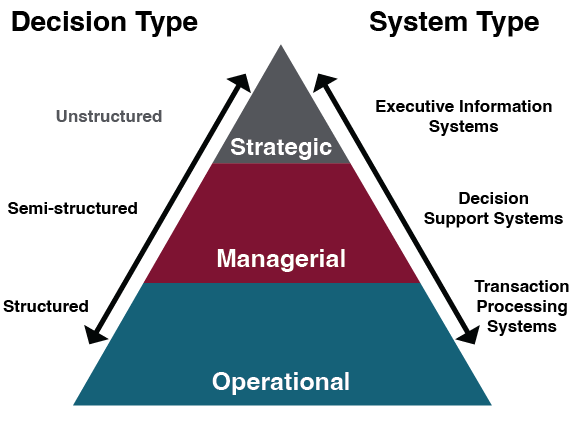12.4: Decision Types
- Page ID
- 94978
\( \newcommand{\vecs}[1]{\overset { \scriptstyle \rightharpoonup} {\mathbf{#1}} } \)
\( \newcommand{\vecd}[1]{\overset{-\!-\!\rightharpoonup}{\vphantom{a}\smash {#1}}} \)
\( \newcommand{\dsum}{\displaystyle\sum\limits} \)
\( \newcommand{\dint}{\displaystyle\int\limits} \)
\( \newcommand{\dlim}{\displaystyle\lim\limits} \)
\( \newcommand{\id}{\mathrm{id}}\) \( \newcommand{\Span}{\mathrm{span}}\)
( \newcommand{\kernel}{\mathrm{null}\,}\) \( \newcommand{\range}{\mathrm{range}\,}\)
\( \newcommand{\RealPart}{\mathrm{Re}}\) \( \newcommand{\ImaginaryPart}{\mathrm{Im}}\)
\( \newcommand{\Argument}{\mathrm{Arg}}\) \( \newcommand{\norm}[1]{\| #1 \|}\)
\( \newcommand{\inner}[2]{\langle #1, #2 \rangle}\)
\( \newcommand{\Span}{\mathrm{span}}\)
\( \newcommand{\id}{\mathrm{id}}\)
\( \newcommand{\Span}{\mathrm{span}}\)
\( \newcommand{\kernel}{\mathrm{null}\,}\)
\( \newcommand{\range}{\mathrm{range}\,}\)
\( \newcommand{\RealPart}{\mathrm{Re}}\)
\( \newcommand{\ImaginaryPart}{\mathrm{Im}}\)
\( \newcommand{\Argument}{\mathrm{Arg}}\)
\( \newcommand{\norm}[1]{\| #1 \|}\)
\( \newcommand{\inner}[2]{\langle #1, #2 \rangle}\)
\( \newcommand{\Span}{\mathrm{span}}\) \( \newcommand{\AA}{\unicode[.8,0]{x212B}}\)
\( \newcommand{\vectorA}[1]{\vec{#1}} % arrow\)
\( \newcommand{\vectorAt}[1]{\vec{\text{#1}}} % arrow\)
\( \newcommand{\vectorB}[1]{\overset { \scriptstyle \rightharpoonup} {\mathbf{#1}} } \)
\( \newcommand{\vectorC}[1]{\textbf{#1}} \)
\( \newcommand{\vectorD}[1]{\overrightarrow{#1}} \)
\( \newcommand{\vectorDt}[1]{\overrightarrow{\text{#1}}} \)
\( \newcommand{\vectE}[1]{\overset{-\!-\!\rightharpoonup}{\vphantom{a}\smash{\mathbf {#1}}}} \)
\( \newcommand{\vecs}[1]{\overset { \scriptstyle \rightharpoonup} {\mathbf{#1}} } \)
\( \newcommand{\vecd}[1]{\overset{-\!-\!\rightharpoonup}{\vphantom{a}\smash {#1}}} \)
\(\newcommand{\avec}{\mathbf a}\) \(\newcommand{\bvec}{\mathbf b}\) \(\newcommand{\cvec}{\mathbf c}\) \(\newcommand{\dvec}{\mathbf d}\) \(\newcommand{\dtil}{\widetilde{\mathbf d}}\) \(\newcommand{\evec}{\mathbf e}\) \(\newcommand{\fvec}{\mathbf f}\) \(\newcommand{\nvec}{\mathbf n}\) \(\newcommand{\pvec}{\mathbf p}\) \(\newcommand{\qvec}{\mathbf q}\) \(\newcommand{\svec}{\mathbf s}\) \(\newcommand{\tvec}{\mathbf t}\) \(\newcommand{\uvec}{\mathbf u}\) \(\newcommand{\vvec}{\mathbf v}\) \(\newcommand{\wvec}{\mathbf w}\) \(\newcommand{\xvec}{\mathbf x}\) \(\newcommand{\yvec}{\mathbf y}\) \(\newcommand{\zvec}{\mathbf z}\) \(\newcommand{\rvec}{\mathbf r}\) \(\newcommand{\mvec}{\mathbf m}\) \(\newcommand{\zerovec}{\mathbf 0}\) \(\newcommand{\onevec}{\mathbf 1}\) \(\newcommand{\real}{\mathbb R}\) \(\newcommand{\twovec}[2]{\left[\begin{array}{r}#1 \\ #2 \end{array}\right]}\) \(\newcommand{\ctwovec}[2]{\left[\begin{array}{c}#1 \\ #2 \end{array}\right]}\) \(\newcommand{\threevec}[3]{\left[\begin{array}{r}#1 \\ #2 \\ #3 \end{array}\right]}\) \(\newcommand{\cthreevec}[3]{\left[\begin{array}{c}#1 \\ #2 \\ #3 \end{array}\right]}\) \(\newcommand{\fourvec}[4]{\left[\begin{array}{r}#1 \\ #2 \\ #3 \\ #4 \end{array}\right]}\) \(\newcommand{\cfourvec}[4]{\left[\begin{array}{c}#1 \\ #2 \\ #3 \\ #4 \end{array}\right]}\) \(\newcommand{\fivevec}[5]{\left[\begin{array}{r}#1 \\ #2 \\ #3 \\ #4 \\ #5 \\ \end{array}\right]}\) \(\newcommand{\cfivevec}[5]{\left[\begin{array}{c}#1 \\ #2 \\ #3 \\ #4 \\ #5 \\ \end{array}\right]}\) \(\newcommand{\mattwo}[4]{\left[\begin{array}{rr}#1 \amp #2 \\ #3 \amp #4 \\ \end{array}\right]}\) \(\newcommand{\laspan}[1]{\text{Span}\{#1\}}\) \(\newcommand{\bcal}{\cal B}\) \(\newcommand{\ccal}{\cal C}\) \(\newcommand{\scal}{\cal S}\) \(\newcommand{\wcal}{\cal W}\) \(\newcommand{\ecal}{\cal E}\) \(\newcommand{\coords}[2]{\left\{#1\right\}_{#2}}\) \(\newcommand{\gray}[1]{\color{gray}{#1}}\) \(\newcommand{\lgray}[1]{\color{lightgray}{#1}}\) \(\newcommand{\rank}{\operatorname{rank}}\) \(\newcommand{\row}{\text{Row}}\) \(\newcommand{\col}{\text{Col}}\) \(\renewcommand{\row}{\text{Row}}\) \(\newcommand{\nul}{\text{Nul}}\) \(\newcommand{\var}{\text{Var}}\) \(\newcommand{\corr}{\text{corr}}\) \(\newcommand{\len}[1]{\left|#1\right|}\) \(\newcommand{\bbar}{\overline{\bvec}}\) \(\newcommand{\bhat}{\widehat{\bvec}}\) \(\newcommand{\bperp}{\bvec^\perp}\) \(\newcommand{\xhat}{\widehat{\xvec}}\) \(\newcommand{\vhat}{\widehat{\vvec}}\) \(\newcommand{\uhat}{\widehat{\uvec}}\) \(\newcommand{\what}{\widehat{\wvec}}\) \(\newcommand{\Sighat}{\widehat{\Sigma}}\) \(\newcommand{\lt}{<}\) \(\newcommand{\gt}{>}\) \(\newcommand{\amp}{&}\) \(\definecolor{fillinmathshade}{gray}{0.9}\)An organization has a wide variety of decisions to make, ranging from highly structured decisions to unstructured decisions. A structured decision is one that is made quite often, and one in which the decision is based directly on the inputs. With structured decisions, once you know the necessary information you also know the decision that needs to be made. For example, inventory reorder levels can be structured decisions. Once your inventory of widgets gets below a specific threshold, there is a need to order more. Processes like this, based on structured decisions, are good candidates for automation. They can also be referred to as programmed decisions.
For programmed decisions, managers often develop heuristics, or mental shortcuts, to help reach a decision. For example, the retail store manager may not know how busy the store will be the week of a big sale, but might routinely increase staff by 30% every time there is a big sale (because this has been fairly effective in the past). Heuristics are efficient—they save time for the decision maker by generating an adequate solution quickly. Heuristics don’t necessarily yield the optimal solution, but a good solution. Heuristics are often used for programmed decisions, because experience in making the decision over and over helps the decision maker know what to expect and how to react. Programmed decision-making can also be taught fairly easily to another person.
In contrast, an unstructured decision or non programmed decision involves a lot of unknowns. They are generally based on criteria that are not well-defined, and information is more likely to be ambiguous or incomplete. The decision maker may need to exercise some thoughtful judgment and creative thinking to reach a good solution. An information system can support these types of decisions by providing the decision makers with information gathering tools and collaborative capabilities. An example of an unstructured decision might be dealing with a labor issue or setting policy for the implementation of a new technology.
A semi-structured decision is one in which most of the factors needed for making the decision are known but human experience and other outside factors may still impact the decision. A good example of a semi-structured decision is the hiring process. Part of the decision is structured (years of experience, education, etc.) and part of the decision is based on human experience (for example: social skills, problem solving skills etc.) Take a look at how companies are trying to program this decision and use algorithms. Semi-structured and unstructured decisions are more challenging and systems may not be able to assist in the process fully. However, advances in artificial intelligence (explored in Chapter 13) are helping to change this.

Decisions can also be classified into three categories based on the level at which they occur.
Strategic decisions set the course of an organization. Tactical/Managerial decisions are decisions about how things will get done. Finally, operational decisions refer to decisions that employees make each day to make the organization run. For example, think about the restaurant that routinely offers a free dessert when a customer complaint is received. The owner of the restaurant made a strategic decision to have great customer service. The manager of the restaurant implemented the free dessert policy as a way to handle customer complaints, which is a tactical decision. Finally, the servers at the restaurant are making individual decisions each day by evaluating whether each customer complaint received is legitimate and warrants a free dessert. Different information systems are used at each level of the company structure to support the different decision types. We explored transaction processing systems in Chapter 11.
| Level of Decision | Examples of Decision | Who Typically Makes Decisions |
|---|---|---|
| Strategic Decisions | Should we merge with another company? Should we pursue a new product line? Should we downsize our organization? |
Top Management Teams, CEOs, and Boards of Directors |
| Tactical Decisions | What should we do to help facilitate employees from the two companies working together? How should we market the new product line? Who should be let go when we downsize? |
Managers |
| Operational Decisions | How often should I communicate with my new coworkers? What should I say to customers about our new product? How will I balance my new work demands? |
Employees throughout the organization |

